Most Sales Teams Miss Quota Because of One Hidden Problem
top wasting reps’ time on broken information — unify, verify, and automate your way to quota.
Blogby JanAugust 18, 2025
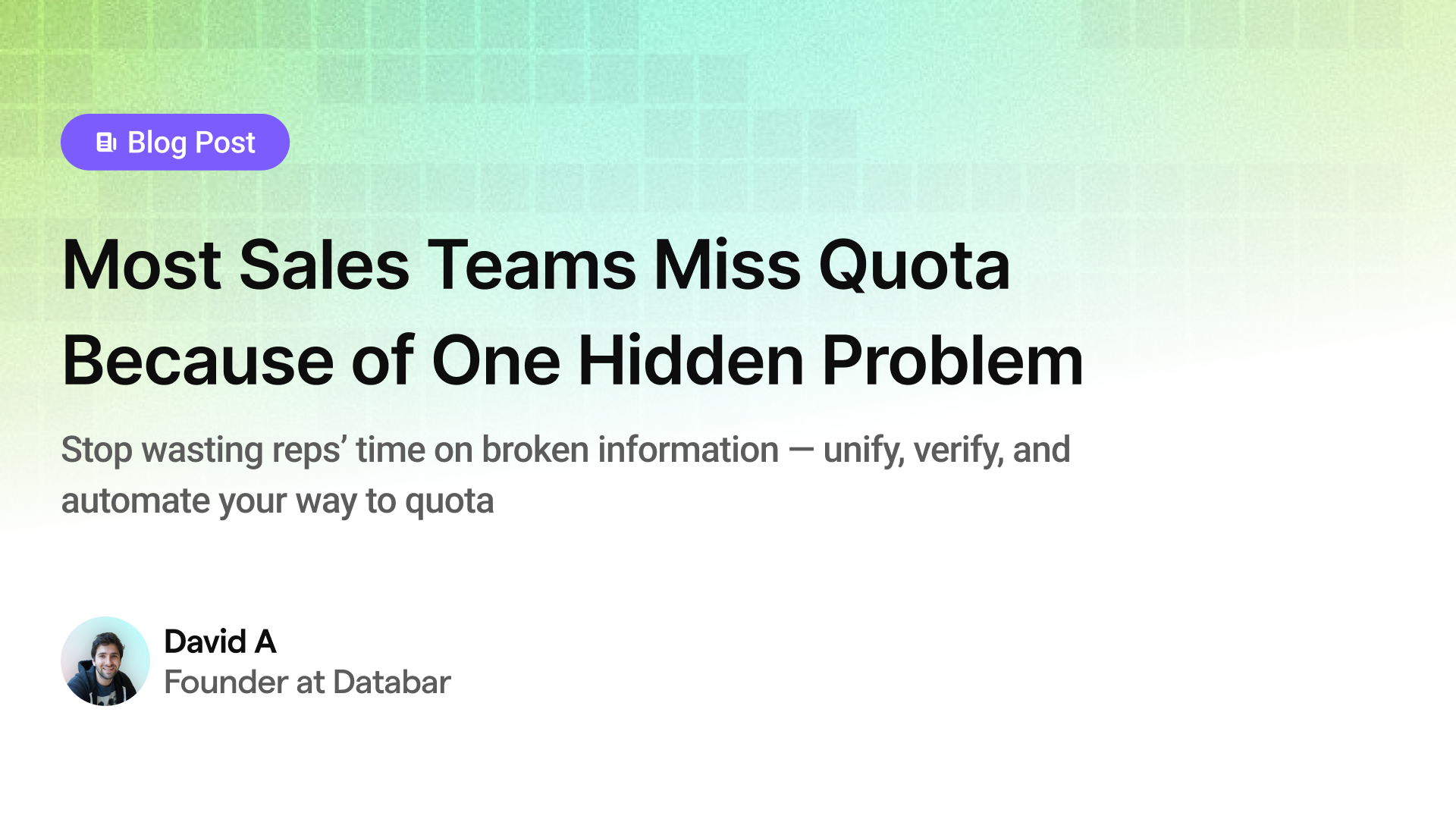
Your sales team just finished another quarter below target. Again. The usual suspects get blamed - market conditions, pricing pressure, competition. But what if the real culprit is hiding in plain sight?
91% of sales organizations missed their quota expectations in 2024. That's not a few underperformers - that's nearly everyone. While sales leaders scramble to fix messaging, adjust territories, and hire more reps, they're missing the foundation that determines whether any of those fixes will work.
The hidden problem isn't your sales process, your pricing, or even your people. It's your data quality. Companies lose up to 20% of revenue due to poor data quality, yet only 3% of business leaders think their department has acceptable data quality levels.
Sales teams do their best work when the data behind them is reliable: every sales activity depends on data accuracy. Wrong phone numbers waste call time. Outdated email addresses kill outreach campaigns. Incorrect job titles mean pitching to the wrong people. Bad company information leads to misaligned messaging. When 47% of newly collected business data contains critical errors, it's impossible to build consistent revenue.
The teams that consistently hit quota aren't necessarily better at selling - they're better at ensuring their sales activities are built on reliable information. While everyone else fights symptoms, top performers solve the underlying data problem that builds the foundation to make everything else work.
The Numbers Don't Lie About Sales Performance
Let's start with the uncomfortable truth about quota attainment. Average quota attainment across B2B sales organizations is just 47%. That means more than half of all salespeople are missing their targets.
But here's where it gets interesting. This isn't a recent development caused by economic uncertainty. Quota attainment has been declining steadily - from 63% in 2011 to 50% in 2016 to current levels below 40% in many industries.
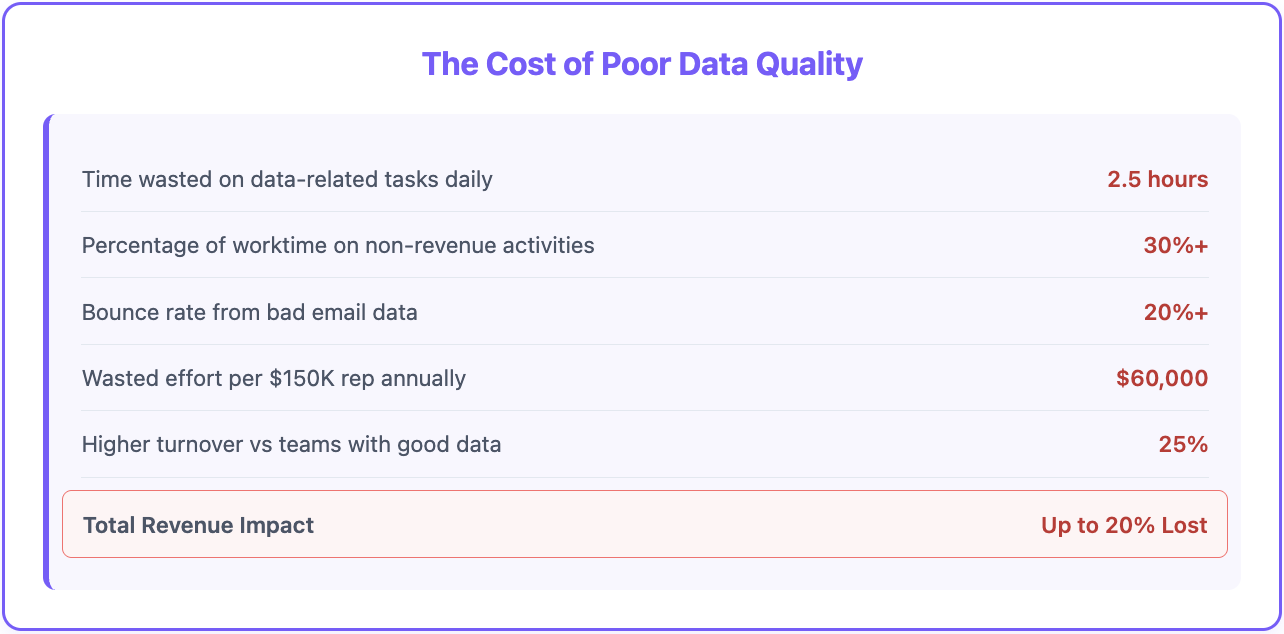
The decline happened during good economic times and bad. Through market expansions and contractions. Across different industries and company sizes. This suggests the problem isn't external market forces - it's something fundamental about how sales teams operate.
67% of organizations don't completely trust their data used for decision-making. When you can't trust your prospect information, target account details, or contact data, every sales activity becomes guesswork rather than strategy.
Consider what happens when sales teams work with unreliable data:
- It takes hours to detect data problems
- 15 hours average to resolve data incidents
- 31% of revenue gets impacted by data quality issues
These aren't minor inconveniences. They're systematic problems that compound throughout the sales process, making quota achievement nearly impossible regardless of individual talent or effort.
What Data Quality Really Means for Sales Teams
Data quality isn't just about having the right phone numbers in your CRM. It's about whether the information driving every sales decision can be trusted to deliver results.
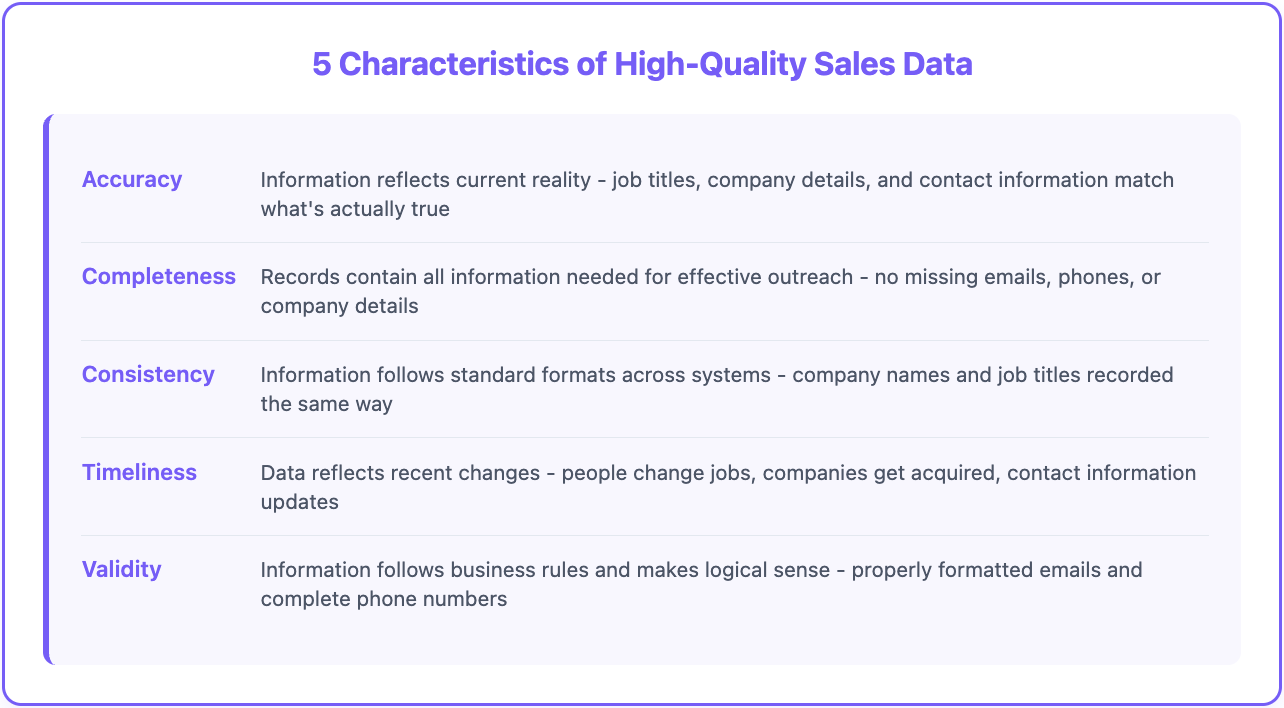
High-quality sales data has five characteristics:
Accuracy - Information reflects current reality. Job titles, company details, and contact information match what's actually true about prospects and accounts.
Completeness - Records contain all the information needed for effective outreach. No missing email addresses, phone numbers, or company details that force reps to spend hours researching.
Consistency - Information follows standard formats and definitions across systems. Company names, job titles, and other details are recorded the same way every time.
Timeliness - Data reflects recent changes. People change jobs, companies get acquired, contact information updates - your data needs to keep pace.
Validity - Information follows business rules and makes logical sense. Email addresses are properly formatted, phone numbers are complete, company data is realistic.
When sales teams have high-quality data, they can focus on selling instead of detective work. Reps with access to reliable prospect information spend 30% more time on actual selling activities compared to those working with poor data.
But when data quality breaks down, everything becomes harder. Calls don't connect. Emails bounce. Messages get sent to the wrong people. Value propositions miss the mark because company information is wrong.
The hidden cost of poor data quality isn't just wasted time - it's the cumulative impact on sales confidence and momentum. When reps can't trust their prospect information, they become cautious and generic rather than confident and specific.
How Bad Data Quietly Destroys Sales Performance
Poor data quality creates a cascade of problems that most sales leaders never connect back to the original source. Here's how it plays out:
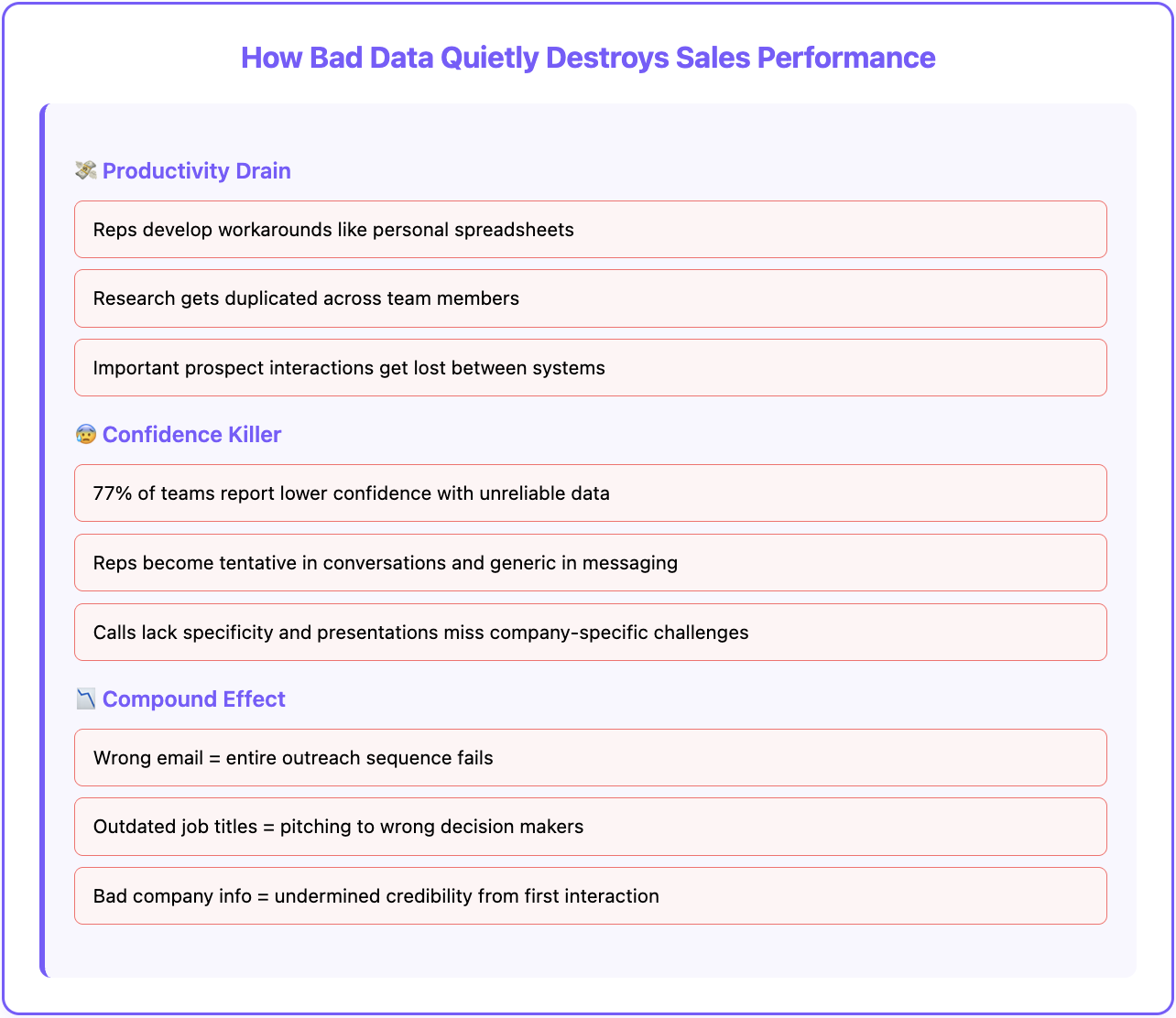
Productivity Drain
Sales reps waste 2.5 hours daily on data-related tasks - verifying contact information, researching prospect details, and cleaning up records. That's over 30% of their working time spent on activities that don't directly generate revenue.
When reps can't trust their CRM data, they develop workarounds. They maintain personal spreadsheets. They re-research prospects they've already contacted. They avoid calling certain types of leads because the data seems unreliable.
These workarounds consume enormous amounts of time while creating new data quality problems. Personal spreadsheets get out of sync with the CRM. Research gets duplicated across team members. Important prospect interactions get lost between systems.
Missing Confidence
Nothing kills sales momentum like uncertainty about basic prospect information. When reps don't trust their data, they become tentative in conversations and generic in messaging.
77% of sales teams report lower confidence levels when working with unreliable prospect data. This shows up in calls that lack specificity, emails that feel impersonal, and presentations that miss the mark on company-specific challenges.
Confident selling requires specific knowledge. The best sales conversations reference recent company news, acknowledge specific industry challenges, and connect solutions to clearly understood business problems. None of this is possible when the underlying data is unreliable.
Compound Effect
Poor data quality doesn't just impact individual activities - it creates compound problems throughout the sales process.
A wrong email address doesn't just mean one bounced message. It means the entire outreach sequence fails. The prospect never enters the nurture campaign. They don't receive follow-up content. The account goes cold despite being perfectly qualified.
Outdated job title information doesn't just mean pitching to the wrong person. It means the message doesn't align with decision-making authority. The value proposition addresses the wrong priorities. The entire sales approach misses the mark.
Incorrect company information doesn't just make conversations awkward. It undermines credibility from the first interaction. Prospects question whether the salesperson understands their business. Trust breaks down before it can be established.
Each data problem creates multiple downstream consequences that make quota achievement progressively more difficult.
What's the Cost of Getting Data Wrong?
While most sales leaders focus on obvious metrics like conversion rates and deal sizes, the real cost of poor data quality shows up in less visible but more damaging ways.
Revenue Impact
Companies with poor data quality lose an average of 20% of potential revenue. This isn't just from obviously bad leads - it's from the systematic degradation of sales effectiveness across all activities.
When outreach campaigns have 20%+ bounce rates due to bad email data, the mathematical impact is enormous. A campaign designed to generate 100 qualified conversations might only produce 70. That 30% reduction compounds through every stage of the sales process.
Consider a typical sales team scenario:
- 1,000 prospects in the database
- 15% bounce rate from bad email addresses = 150 lost opportunities
- 25% wrong phone numbers = 250 wasted call attempts
- 20% outdated job titles = 200 misdirected messages
- Net result: 40% reduction in effective prospect engagement
Time and Resource Waste
Sales teams spend up to 40% of their time on data-related activities rather than actual selling. This includes:
- Researching and verifying prospect information
- Cleaning up CRM records
- Re-entering data across multiple systems
- Following up on bounced emails and failed calls
For a sales team with fully-loaded costs of $150,000 per rep annually, poor data quality effectively wastes $60,000 per person in misdirected effort.
But the hidden cost is opportunity cost. While reps spend time fixing data problems, they're not having conversations with qualified prospects. Every hour spent on data cleanup is an hour not spent selling.
Team Morale and Retention
Poor data quality creates frustration that extends far beyond immediate productivity impacts. 68% of sales reps report lower job satisfaction when working with unreliable prospect data.
Reps become demoralized when their efforts don't produce results due to factors outside their control. Making 50 calls and connecting with 10 prospects feels productive. Making 50 calls and connecting with 2 prospects due to bad phone numbers feels like failure.
This leads to higher turnover rates, longer ramp times for new hires, and reduced overall team performance. Sales teams with poor data quality experience 25% higher turnover compared to those with reliable prospect information.
Why Traditional Solutions Keep Failing
Most sales teams try to solve quota challenges by adjusting activities, processes, or people. They increase call volumes, modify messaging, provide more training, or hire additional reps. These approaches treat symptoms while ignoring the underlying data foundation.
Activity Trap
When performance lags, the natural response is to increase activity. Make more calls. Send more emails. Book more meetings. But when the underlying data is unreliable, more activity just amplifies the problem.
Increasing outreach volume with poor data quality actually makes performance worse. More bad phone numbers mean more wasted calls. More invalid email addresses mean higher bounce rates and damaged sender reputation. More incorrect prospect information means more misaligned conversations.
Teams get caught in a cycle where poor performance drives increased activity, which exposes more data problems, which further degrades performance.
Process Improvement Mirage
Sales process improvements can't overcome fundamental data problems. The best qualification framework is useless if prospect company information is wrong. Perfect discovery questions don't help if you're talking to someone who isn't the decision maker.
87% of sales leaders have no systematic method for setting quota targets, partly because they can't trust their data enough to make accurate projections. When pipeline reporting is based on unreliable prospect information, forecasts become meaningless.
Process improvements work when they're built on a foundation of reliable data. Without that foundation, they're just more sophisticated ways to fail.
Technology Band-Aid
Many teams try to solve data problems by adding more tools. New prospecting platforms. Additional enrichment services. CRM add-ons for data cleansing. But tools don't fix data problems - they just create more places for bad data to hide.
The average sales team uses 6-8 different tools for prospecting, enrichment, and customer management. When data quality is poor across all these systems, adding more tools increases complexity without improving outcomes.
The real solution isn't more tools - it's ensuring the data flowing through existing tools is accurate, complete, and reliable.
How Databar Solves the Data Quality Problem
While most sales teams struggle with scattered data sources and manual verification processes, Databar was built specifically to solve the data quality crisis that prevents quota achievement. Our platform addresses every aspect of the data quality challenge through systematic automation and verification.
Unified Data Access with 90+ Premium Sources
Instead of relying on single data providers that deliver incomplete information, Databar integrates with over 90 premium data sources to ensure comprehensive, accurate prospect intelligence. Our waterfall enrichment approach automatically checks multiple providers sequentially until complete, verified information is found.
When one data source shows a prospect's email is outdated, Databar automatically queries the next provider, and the next, until current contact information is discovered. This approach typically achieves 80%+ match rates compared to 40-50% from single-source solutions.
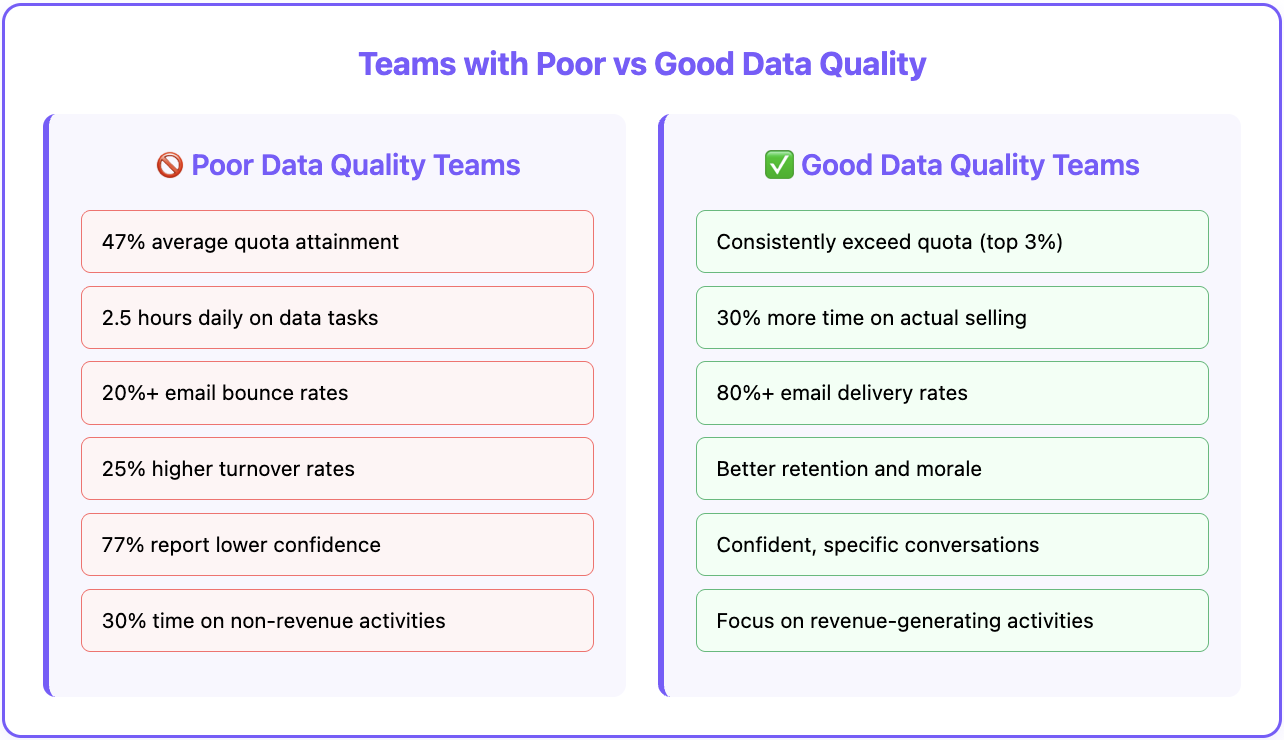
Real-Time Data Verification and Validation
Databar eliminates the data quality problems that destroy sales campaigns before they begin. Every piece of contact information gets verified automatically:
Email validation happens before outreach campaigns launch, preventing bounce rates that damage sender reputation and waste sales effort.
Phone number verification ensures call attempts connect to active numbers, eliminating the productivity drain of dialing disconnected lines.
Company data accuracy checks maintain current business information, so messaging aligns with actual company priorities and challenges.
Automated Data Enrichment Workflows
Using our Complete LinkedIn Profile Enrichment workflow, sales teams transform basic contact information into comprehensive prospect intelligence instantly:
- Extract complete personal and company data from LinkedIn URLs
- Find and verify email addresses and phone numbers automatically
- Enrich both personal and company profiles with current information
- Standardize names and company data for direct CRM integration
What traditionally takes 15-30 minutes of manual research across multiple platforms now happens in under 30 seconds with verified accuracy.
AI-Powered Data Quality Maintenance
Databar's AI capabilities don't just gather data - they ensure ongoing quality and relevance:
Our HubSpot CRM Enrichment & Sync workflow automatically:
- Validates email deliverability through waterfall methods
- Extracts missing website URLs from email domains
- Enriches LinkedIn profiles and detects job changes using AI
- Updates CRM records with validated, current information
This eliminates the manual data hygiene work that consumes a big chunk of sales rep time while ensuring CRM data stays current and actionable.
Seamless Integration That Prevents Data Silos
Rather than creating another data source that needs manual management, Databar integrates directly with existing sales tools. Enriched, verified data flows automatically into:
- CRM systems like HubSpot, Salesforce, and Pipedrive
- Email platforms like Instantly, Lemlist, and Smartlead
- Sales engagement tools and marketing automation platforms
- Custom integration via API
This integration ensures data quality improvements happen within existing workflows rather than requiring new processes or additional tools.
Systematic Approach to Data Quality
The key difference is systematic elimination of data quality problems at the source. Instead of expecting sales reps to verify information manually or clean up bad data after campaigns fail, Databar prevents data quality issues from entering sales workflows.
As we explored in our analysis of why sales reps waste 3.2 hours daily on manual prospecting, manual data verification processes create productivity drains that compound throughout the sales process. Databar's automated approach eliminates these inefficiencies while ensuring superior data accuracy.
Teams using Databar typically see immediate improvements in email deliverability, call connection rates, and message relevance - the foundational metrics that determine whether sales activities can generate pipeline and revenue.
What High-Performing Teams Do Differently
The 3% of sales teams that consistently exceed quota aren't just better at selling - they've solved the data quality problem that enables everything else to work effectively.
Systematic Data Management
Top-performing teams treat data quality as a strategic priority, not an operational afterthought. They have clear processes for:
- Validating prospect information before it enters sales workflows
- Maintaining data accuracy as prospects move through the pipeline
- Regular cleanup and enrichment of existing records
- Monitoring data quality metrics alongside sales performance metrics
These teams spend 15% of their time on data management but achieve 40% better results because their selling activities are built on reliable information.
Real-Time Data Verification
Rather than discovering data problems after campaigns fail, leading teams verify information before outreach begins. They use automated tools to:
- Validate email addresses before sending messages
- Verify phone numbers before making calls
- Check prospect job titles and company information for accuracy
- Enrich incomplete records with missing details
This prevents the cascade of problems that poor data creates throughout the sales process.
Cross-Team Collaboration
High-performing sales organizations align data quality efforts across marketing, sales operations, and revenue teams. Everyone understands that data quality is a shared responsibility that impacts overall revenue performance.
Marketing ensures lead data is accurate before handoff. Sales operations maintains CRM hygiene and provides regular data audits. Sales teams flag quality issues and follow data entry standards.
This collaborative approach prevents data problems from developing and provides rapid resolution when issues arise.
Taking Action: Your Data Quality Sprint
Rather than overwhelming teams with complex data transformation projects, start with focused improvements that deliver immediate results.
Step 1: Email Data Cleanup Impact: improvement in outreach effectiveness
- Validate all email addresses in active prospect lists
- Remove or fix bounced and invalid addresses
- Implement real-time email verification for new prospects
- Monitor bounce rates and delivery metrics
Step 2: Phone Number Verification Impact: improvement in call connection rates
- Verify phone numbers for all active prospects
- Standardize phone number formats across systems
- Add mobile vs. direct line indicators where available
- Test connectivity rates and update invalid numbers
Step 3: Job Title and Company Standardization Impact: improvement in message relevance
- Standardize job titles across prospect records
- Verify current employment and company details
- Update organizational changes and personnel moves
- Enrich missing company information
Step 4: Integration and Automation Impact: Sustainable long-term improvement
- Implement automated data validation workflows
- Set up regular data quality monitoring
- Train team on new processes and standards
- Measure improvement in sales metrics
Teams that complete this 30-day sprint typically see 25-40% improvement in sales performance metrics within 60 days.
Why Data Quality Is Your Competitive Advantage
While competitors struggle with the same data problems that have plagued sales teams for years, organizations that solve data quality gain an immediate and sustainable competitive advantage.
Reliable data enables confident selling. When reps trust their prospect information, they can be specific and relevant in conversations. They reference accurate company details, address real business challenges, and connect with the right decision makers.
Clean data improves every sales metric. Higher email delivery rates. Better call connection rates. More relevant messaging. Shorter sales cycles. Larger deal sizes. Higher quota attainment.
Quality data scales efficiently. Rather than requiring more reps to generate more revenue, improved data quality lets existing teams achieve better results with the same effort.
The companies that figure this out first will capture market share while competitors continue fighting uphill battles against their own data problems.
The Path Forward
Many sales teams miss quota because they're trying to sell effectively while working with unreliable information. It's like trying to build a house on a foundation of sand - no matter how good your construction skills, the structure won't hold.
The solution isn't more activity, better processes, or additional training. It's ensuring that every sales activity is built on a foundation of accurate, complete, and reliable data.
Teams that solve the data quality problem see immediate improvements in performance metrics and long-term improvements in quota attainment. More importantly, they create sustainable competitive advantages that compound over time.
The question isn't whether your team has data quality problems - it's whether you'll fix them before your competitors do.
For sales leaders ready to solve the foundation problem that makes everything else work, the path is clear: audit your current data quality, implement systematic improvement processes, and measure the impact on actual sales performance.
Because in a world where numerous of teams miss quota, being among the 3% that consistently exceed targets isn't just about selling better - it's about building sales success on a foundation of reliable information.
Ready to Fix Your Data Foundation?
The most successful sales teams don't just work harder - they work with better information. If you're ready to solve the data quality problems that make quota achievement possible, here are the resources that can help:
Sales Reps Waste Half Their Day on This One Activity - Discover the hidden productivity drain that's killing your team's performance
How Elite Sales Teams Really Find Their Best Prospects - Learn the systematic approaches top performers use for prospect intelligence
Why Your Best Sales Reps Are Leaving Money on the Table - Understand the productivity killers that prevent even top performers from reaching their potential
The difference between missing quota and exceeding it often comes down to one factor: working with information you can trust. Start fixing your data foundation today, and watch your sales performance transform over the next quarter.
Frequently Asked Questions
What percentage of sales teams actually miss quota each year?
Numerous of sales organizations missed their quota expectations in 2024, with average quota attainment across B2B sales organizations at just 47%. This isn't a recent trend - quota attainment has been declining steadily from 63% in 2011 to current levels below 40% in many industries, regardless of economic conditions.
How much revenue do companies lose due to poor data quality?
Companies lose up to 20% of potential revenue due to poor data quality issues. When outreach campaigns have 20%+ bounce rates from bad email data, a campaign designed to generate 100 qualified conversations might only produce 70, with that 30% reduction compounding through every stage of the sales process.
How much time do sales reps waste on data-related tasks?
Sales reps waste 2.5 hours daily on data-related tasks - over 30% of their working time spent on activities that don't directly generate revenue. This includes verifying contact information, researching prospect details, cleaning up CRM records, and following up on bounced emails and failed calls.
What are the five characteristics of high-quality sales data?
High-quality sales data must be: 1) Accurate - reflecting current reality about prospects and companies, 2) Complete - containing all information needed for effective outreach, 3) Consistent - following standard formats across systems, 4) Timely - reflecting recent changes like job moves or company updates, and 5) Valid - following business rules and making logical sense.
Why do traditional solutions like increasing activity or improving processes fail to solve quota problems?
Traditional solutions fail because they treat symptoms rather than the underlying data foundation. Increasing outreach volume with poor data quality amplifies problems - more bad phone numbers mean more wasted calls, more invalid emails mean higher bounce rates. Process improvements can't overcome fundamental data problems when the information driving decisions is unreliable.
What's the total cost impact of poor data quality on sales teams?
For a sales team with fully-loaded costs of $150,000 per rep annually, poor data quality effectively wastes $60,000 per person in misdirected effort. Beyond direct costs, poor data quality creates opportunity costs where reps spend time fixing data problems instead of having conversations with qualified prospects, plus compound effects throughout the sales process.
How can sales leaders measure and monitor data quality in their organization?
Sales leaders should conduct comprehensive data audits measuring CRM data completeness and accuracy rates, email deliverability and bounce rate analysis, phone number connectivity assessment, and prospect information verification. Regular monitoring should track data accuracy metrics alongside sales performance metrics, connecting data quality directly to revenue outcomes.
Related articles
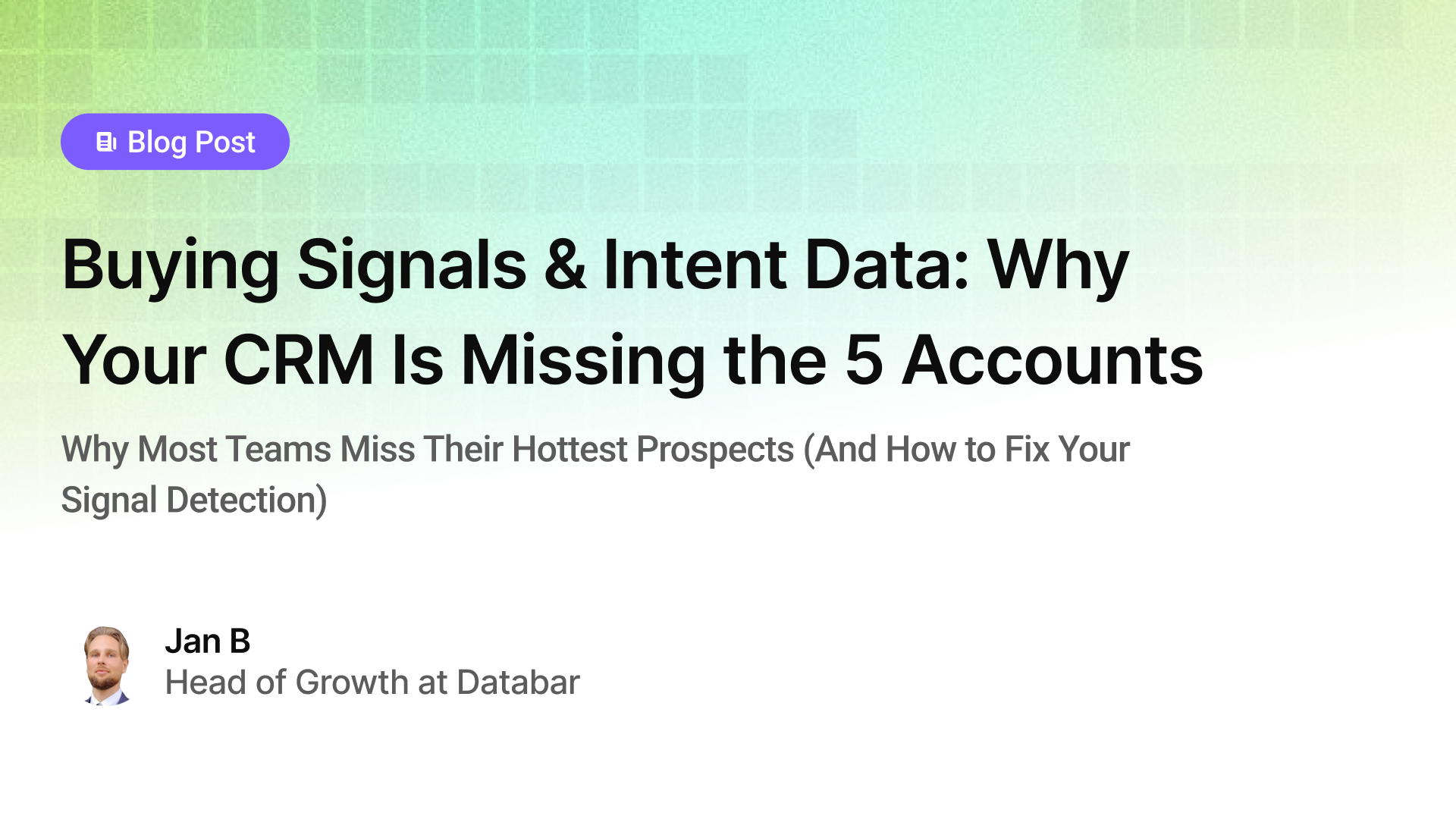
Buying Signals & Intent Data: Why Your CRM Is Missing the 5 Accounts
Why Most Teams Miss Their Hottest Prospects (And How to Fix Your Signal Detection)
by Jan, October 06, 2025

Lead Scoring & Account Segmentation: Why Most CRMs Get This Backward (And How to Fix It)
How to build a system that tells your team who to call, when, and why
by Jan, October 06, 2025
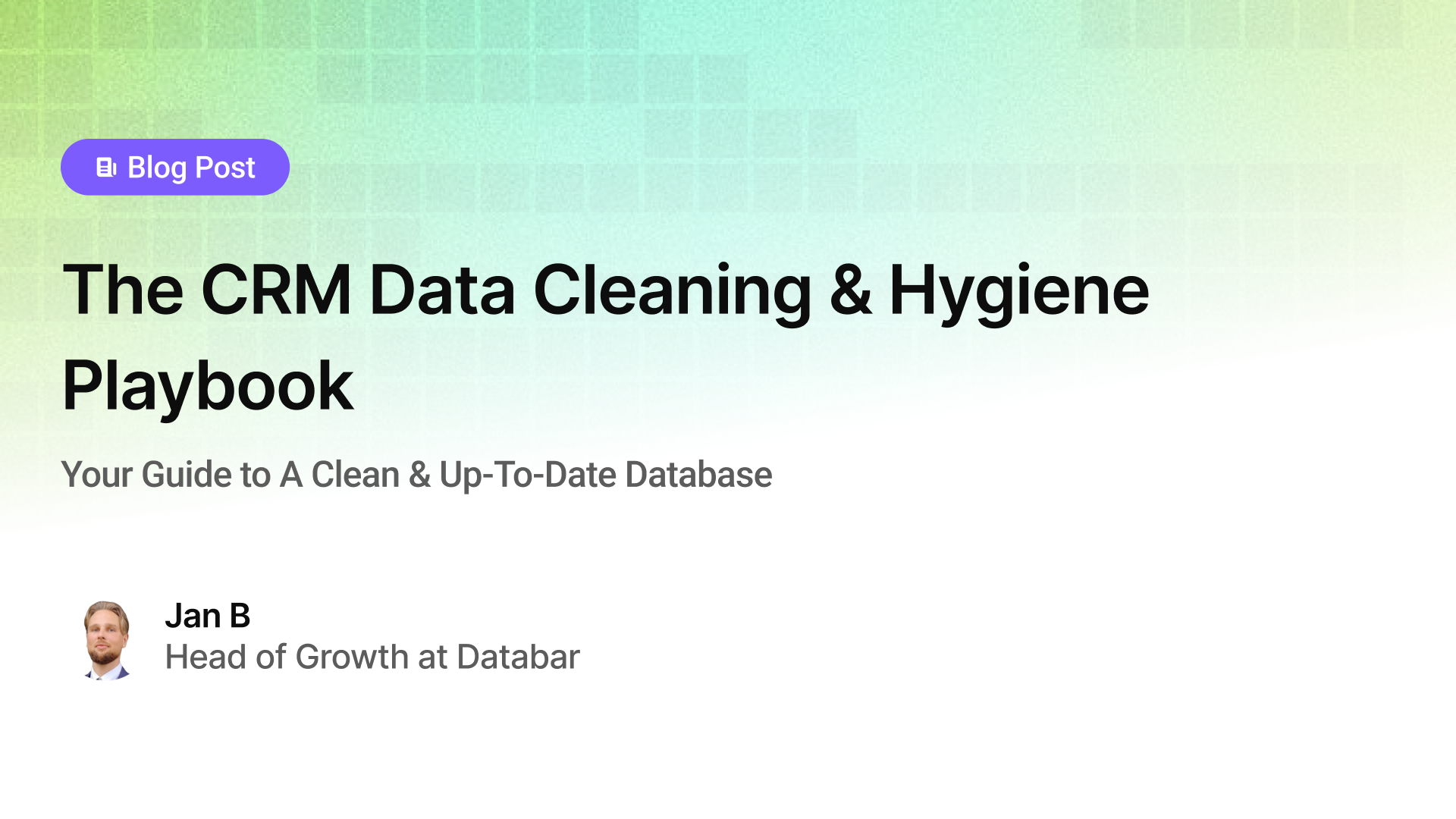
The CRM Data Cleaning & Hygiene Playbook
Your Guide to A Clean & Up-To-Date Database
by Jan, October 04, 2025

Everything You Need To Know About CRM Enrichment
Your Step-By-Step Guide To CRM Data Enrichment
by Jan, October 03, 2025

